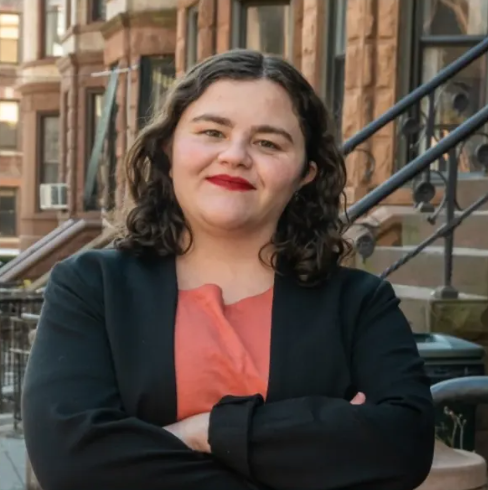
Lydia Green, a District Leader for the Democratic Party in northwest Brooklyn, will be primarying Jo Anne Simon for a seat in the state legislature next year. Photo: @lydiagreenbk
By JACK DELANEY | jdelaney@queensledger.com
Lydia Green, a twenty-nine-year-old organizer currently serving as a District Leader for District 52, is challenging long-time Assembly Member Jo Anne Simon for her seat in the same Brooklyn jurisdiction, which runs from DUMBO to Park Slope.
Green announced her bid on Monday, December 14, through a post on Instagram, positioning herself as an antidote to “establishment politicians” who “cater to niche interest groups rather than organizing towards the common good.”
“I grew up right here in Park Slope and am a product of Brooklyn public schools,” Green wrote. “This district is where I learned how to walk and write, multiply and march, and push for progress. But this district is also where I’ve learned how our government has failed us.”
Green is reaching the end of her two-year term as District Leader, an unpaid but elected position within the Democratic Party that focuses on grassroots outreach. Each Assembly District votes for two District Leaders — one male, one female — who help to elect county party chairs, nominate judges, choose poll workers, and organize voter registration drives.
“As a District Leader, I passed resolutions calling for single-payer health care and free public college,” said Green. “I’ll bring this same courage and energy to the Assembly.”
Green previously worked as a staffer on eight progressive campaigns, ranging from City Council to Congress. Her own candidacy comes at an inflection point for New York politics, as a new guard of young leftists seeks oust older, often more centrist leaders — and to fill the legislature with allies of Mayor-elect Zohran Mamdani. (This generational rift is a national one: A recent Harvard poll found that 57% of voters aged 18 to 42 disapproved of the Democratic Party.)
“In both the mayoral primary and general election, voters of this district have indicated that they are hungry for a bold and unapologetically progressive type of politics,” Green told the Star, noting that she would be “a true partner with our Mayor-elect to deliver on the incoming administration’s affordability agenda for western Brooklyn.”
Green’s platform rests upon three issues: taxing the rich to fund public schools and childcare, increasing the housing stock and protecting tenants, and climate-proofing this corner of Brooklyn.
“In this district, our rents have skyrocketed, the climate crisis has flooded our waterfronts, and the few have become richer at the expense of everybody else,” said Green.
District 52 encompasses many of the most heavily gentrified neighborhoods in the borough, although areas like Gowanus still carry baggage from their industrial past.
But as officials push to build hundreds of thousands of units amid a citywide housing crisis, the incumbent, former disability rights lawyer Jo Anne Simon, has taken on high-profile roles in negotiations over multi-billion dollar projects in nearby districts — chief among them the Brooklyn Marine Terminal (BMT) in Red Hook and Atlantic Yards in Downtown Brooklyn.
Simon, 73, was a founding member of BrooklynSpeaks, a community organization that has critiqued the developers of Atlantic Yards, and joined local Red Hook reps in voting against the BMT plan, saying it needed additional studies into whether the area’s sewers and roads could accommodate a major influx of residents.
Yet Green, like local Council Member Shahana Hanif, 34, who voted yes on the BMT proposal, gestured in her campaign launch at frustrations with the slow pace of development amid a citywide housing crisis.
Green, who is queer and Jewish, traces her family’s roots in Brooklyn to Bath Beach. “My ancestors came to America with very little but eventually they were able to start their own kosher butcher shop that lasted multiple generations and helped the family survive the Great Depression,” she shared in an interview with The Workers Circle.
Now seeking to represent the borough’s western shoulder, Green will look to best Simon — who came up short in a bid to become borough president in 2021, but won her latest primary in 2024 with 80% of the vote — next November, since Assembly members are elected to two-year terms without term limits.
“Whether it’s the looming threat of ICE raids, the deepening affordability crisis, or the desperate need for housing, Brooklynites need and deserve a fierce champion,” Green said on Monday. “I’m running to be that champion.”












